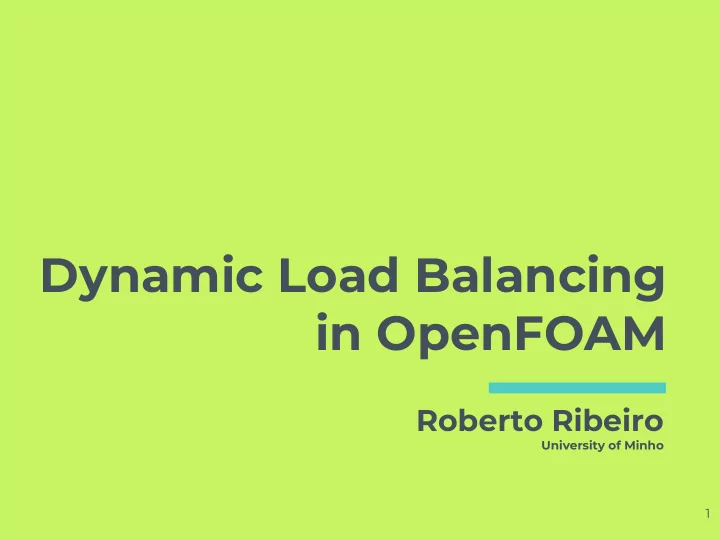

Dynamic Load Balancing in OpenFOAM Roberto Ribeiro University of Minho 1
Context CFD + HPC CFD needs computing power the more the best HPC systems can provide it In particular, clusters (distributed memory systems) that are: ● Easily extensible ● Cost-effective 2
Context Heterogeneous systems Clusters are typically extended with new nodes from newer generations There is also a plurality of computing devices Systems are rendered highly heterogeneous Top500 List Statistics November 2017 3
Heterogeneous Computing Era Modern parallel computing systems are composed by a plurality of computing units from different generations and exhibiting different architectures and execution models. 4
Motivation Challenges Performance imbalances Faster nodes wait for slower nodes Resource idling Results in overall resource underutilization 5
Motivation Dynamic workloads Dynamic workloads e.g. Adaptive Mesh Refinement (dynamicRefineFvMesh) Cells are divided or merged in runtime Depends on flow and other physical properties Therefore, workload is dynamic and unpredictable 6
Motivation More challenging with dynamic workloads More imbalance More resource idling More resource underutilization This time, unpredictable and steamed from a far more complex code/execution 7
Two-fold challenge + Heterogeneous Dynamic Systems workload 8
How do we propose to address it Heterogeneity-aware Dynamic Load Balancing Online Profiling Performance Module Model Decision Repartitioning Module Module 9
Online Profiling Module (OPM) Performance Model (PM) ● OpenFOAM Instrumentation ● Per CU performance characterization Low-level and relevant to execution time routines Defines a FV cell as work unit ● ● Separation/sieving of computation vs Basically, estimates the time required to ● ● communication process a cell for each CU ● Information provided to PM ● Enables execution-time estimation of arbitrary workloads for each CU Information provided to DM ● Decision Module (DM) Repartitioning Module (RM) ● Triggers re-balance based on the compute time ● Partitioner interfaced as a 3rd party tool -- in this (OPM) Relative Standard Deviation across CUs case ParMETIS Linear equation system to determine a balanced Uses part of OpenFOAM ParMETIS routines plus ● ● distribution based on current load and PM info newly introduced ones to support refined meshes ● Requests RM re-distribution candidates ● Benefits from ParMETIS partitioning features: Estimate re-distribution benefit based on Balanced re- distribution based on ● ○ migration cost (LR), iterations left and time gain performance weights from DM (PM) Boundary minimization ○ ● Choose best redistribution and if beneficial, trigger ● Multiple decompositions requested to partitioner migration (learning process converging to one decomposition requested) 10
Results Evaluation systems damBreak interDyMFoam dynamicRefineFvMesh 11
Results SeARCH Homogeneous and Heterogeneous I configurations 12
Results Work and resource scalability 13
Results Increased extracted performance 14
Future work Evaluate with larger node counts Validate with more/different problems Devise support and evaluate different dynamic workloads (e.g. particles, moving meshes) Deploy 15
Acknowledgements ● This work is funded by FEDER funds through the COMPETE 2020 Programme and National Funds through FCT - Portuguese Foundation for Science and Technology under the project UID/CTM/50025/2013. ● Minho University cluster under the project Search-ON2 Revitalization of HPC infrastructure of UMinho, ○ (NORTE-07-0162-FEDER-000086), co-funded by the North Portugal Regional Operational Programme (ON.2-0 Novo Norte), under the National Strategic Reference Framework (NSRF), through the European Regional Development Fund (ERDF). PT-FLAD Chair on Smart Cities & Smart Governance ● School of Engineering, University of Minho within project Performance ● Portability on Scalable Heterogeneous Computing Systems ● Texas Advanced Computing Center (TACC) at The University of Texas at Austin 16
nSharma: Numerical Simulation Heterogeneity Aware Runtime Manager for OpenFOAM, R. Ribeiro, L. P. Santos, and J. M. Nóbrega, accepted in International Conference on Computational Science (ICCS), 2018 rribeiro@di.uminho.pt 17
Recommend
More recommend